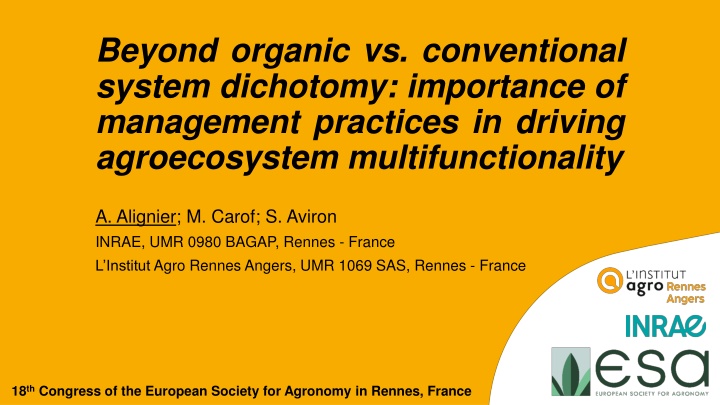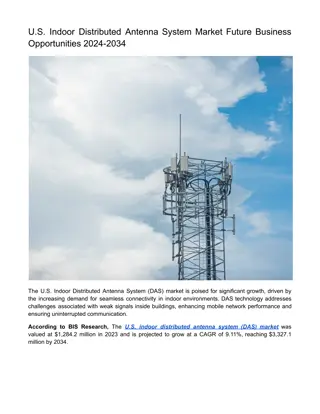
Importance of Management Practices in Agroecosystem Multifunctionality
This research explores the significance of management practices in driving agroecosystem multifunctionality, emphasizing the transition towards sustainable agriculture. The study assesses existing cropping systems using the concept of multifunctional agriculture, comparing conventional and organic farming approaches. The research aims to understand how annual cropping systems impact multifunctionality and the trade-offs and synergies among agronomic, ecological, social, and economic functions. By examining different levels of management practices, the study seeks to identify ways to enhance synergies between crop production and other functions.
Uploaded on | 1 Views
Download Presentation

Please find below an Image/Link to download the presentation.
The content on the website is provided AS IS for your information and personal use only. It may not be sold, licensed, or shared on other websites without obtaining consent from the author. If you encounter any issues during the download, it is possible that the publisher has removed the file from their server.
You are allowed to download the files provided on this website for personal or commercial use, subject to the condition that they are used lawfully. All files are the property of their respective owners.
The content on the website is provided AS IS for your information and personal use only. It may not be sold, licensed, or shared on other websites without obtaining consent from the author.
E N D
Presentation Transcript
Beyond organic vs. conventional system dichotomy: importance of management practices in driving agroecosystem multifunctionality A. Alignier; M. Carof; S. Aviron INRAE, UMR 0980 BAGAP, Rennes - France L Institut Agro Rennes Angers, UMR 1069 SAS, Rennes - France 18thCongress of the European Society for Agronomy in Rennes, France
Transition towards sustainable agriculture Facing with many challenges, agriculture requires profound changes and the development of innovative cropping systems (Dor 2011; Mal zieux 2012; Gaba et al. 2015). Sustainable agriculture implies : - the production of sufficient amounts of agricultural products to feed the population - without damaging the environment, preserving natural resources and biodiversity - whilst maintaining the income and quality of life of farmers. Identifying the strengths and weaknesses of existing cropping systems, i.e. optimizing management practices and enhancing multiple functions, is a key first step before designing new, more sustainable cropping systems (Deytieux et al. 2016).
Assessing existing cropping systems The concept of multifunctional agriculture (MFA) can be a useful tool for cropping system assessment. Multifunctionality = simultaneous provision of multiple functions, ensuring the delivery of diverse ecosystem services important for human well-being (St rck and Verburg, 2017) MFA studies typically compare conventional vs. organic farming (Tuck et al. 2014; Ostandie et al. 2022; Couthouis et al. 2023) and ignore gradients of management practices. Paracchini et al. (2015) Organic systems Conventional systems Mechanical weeding Synthetic inputs
Our reseach question How annual cropping systems affect multifunctionality and, trade-offs and synergies among agronomic, ecological, social and economic functions? Can management practices, whether combined or on their be mobilized to foster synergies between crop production and other functions ? 3 levels of management practices description Farming system organic vs. conventional Individual management practices Cropping system i.e. combination of management practices
Study design Field measurements Performances N = 4 Functions N = 7 Proxies N = 14 Ecological Biodiversity conservation Sp. richness of plants, carabids and pollinating insects Pest predation Abund. of carabids, spiders,staphylinids, aphidophagous syrphid, ladybird larvae Pest infestation Abund. of aphids and weeds 40 winter wheat fields: 20 conventional + 20 organic Pollination capacity Abund. of pollinating insects Agronomic Food & feed production Yield Social Labor time Working hours Economic Income contribution Semi-net margin Farmers interviews Couthouis et al. (2023)
Cropping system characterization Organic farming Group 1: low inputs, few field interventions Hierarchical Classification (CAH) Group 2: late sowing, meadow as preceding crop, rather low inputs conventional Group 3: high organic input, many mechanical operations organic Group 4: maize as preceding crop, systemic ploughing, moderate inputs, moderate TFI Group 5: high mineral inputs, high TFI Axes 1-2 : 46% Conventional farming Variables included in PCA : Sowing date, preceding crop, intermediary crop, organic fertilization,mineral fertilization, ploughing, mechanical operations post- sowing, pesticide use (Treatment Frequency Index), number of field interventions
Statistical analyses Calculation of functions and multifunctionality index : Standardization (0-1) of each proxy by the min & max values, across all fields. Averaging proxies values to obtain a value for each function (N =7). Averaging function values to obtain a multifunctionality index. 3 levels of 3 types of Generalized Linear Mixed effect Models (GLMMs) management practices description Farming system Mulifunctionality index OR Function values + 1| Landscape Cropping system ~ Individual management practices
Comparing organic vs. conventional Organic Conventional * No significant difference in multifunctionality index in line with Herzog et al. (2019) in annual and Ostandie et al. (2022) in perennial crops INCOME CONTRIBUTION * Trade-off between biodiversity conservation and crop production in line with Wittwer et al. (2021) and Gong et al. (2022) Higher values for biodiversity-based functions in organic systems * LABOR TIME Similar social and economic performances in line with Sutherland et al. (2012) and Seufert and Ramankutty (2017) * FOOD AND FEED PRODUCTION * CAPACITY * indicates significant difference between OF and CF
Comparing cropping systems Cropping systems Rather similar multifunctionality Group 1 with the highest value Group 3 with the lowest value Cropping systems
Comparing cropping systems Antagonisms Cropping systems Rather similar multifunctionality values Trade-off between biodiversity conservation and crop production Cropping systems
Comparing cropping systems Antagonisms Cropping systems Rather similar multifunctionality values Trade-off between biodiversity conservation and crop production Similar income contribution Cropping systems
Comparing cropping systems N inputs nb. interventions Group 1: biodiversity-friendly Cropping systems
Comparing cropping systems N inputs nb. interventions Group 1: biodiversity-friendly Group 5: productivist Cropping systems
Comparing cropping systems N inputs nb. interventions Group 1: biodiversity-friendly Group 5: productivist Group 3: labor intensive Various strategies for similar income Cropping systems
Take-home messages Similar multifunctionality values can be achieved through different management paths. No cropping system reconciles crop production with biodiversity conservation suggesting current policies and incentives must be strenghtened Need to clarify farmers strategic reasoning behind cropping system choices, which goes beyond cost benefit considerations i.e. personal, social, technical, external factors This calls for substantial increases in knowledge and experience sharing among scientists and farmers about management practices, combined or on their own, and their efficient use to enhance multiple performances underlying sustainable agriculture. 18thCongress of the European Society for Agronomy in Rennes, France

